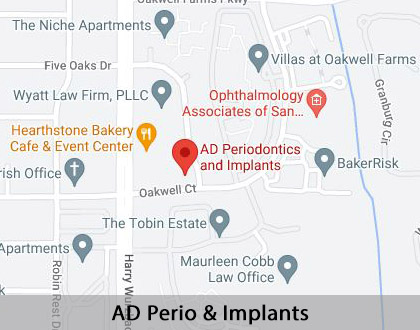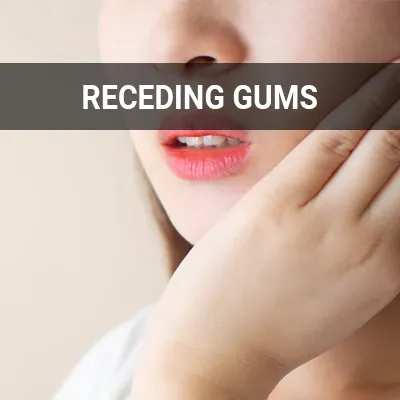Pocket Reduction Surgery San Antonio, TX
The primary purpose of pocket reduction surgery is to reduce the pockets between the base of teeth and gums. These pockets generally result from advanced gum or periodontal disease. The surgery also removes bacteria that get inside the pockets and wear down bone and supportive tissue.
There are different types of pocket reduction surgery, depending on the nature and severity of the damage from bacteria. This procedure can help bring back a patient's natural smile and help them avoid tooth extraction. Regular dental check-ups, professional cleanings, and good oral hygiene can prevent most cases of gum disease that require pocket reduction surgery.
Pocket reduction surgery is available at AD Perio & Implants in San Antonio and the surrounding area. Call us at (210) 805-8400 to learn more or schedule an appointment.
What is Pocket Reduction Surgery?
Pockets refer to the gaps between the gums and base of teeth. In healthy mouths, pockets are typically less than 2-3 millimeters. However, gum disease can expand these gaps, and when they increase beyond 5 millimeters, they allow more bacteria to come in. As more bacteria enter the tooth area and wear down bone and tissue, the pockets expand until the tooth requires extraction.
Pocket reduction surgery—or osseous surgery—saves the tooth by removing the bacteria in those pockets and repairing the damaged bone. A periodontist typically performs this procedure, which usually lasts about two hours. The steps in the process include:
- The patient receives a local anesthetic in the gums surrounding the damaged tooth. They might also get an oral medication or intravenous sedation to induce calm.
- The periodontist cuts along the gumline and then folds back the gums to expose and remove the bacteria.
- The periodontist smooths down uneven parts of the damaged bone.
- A severely damaged tooth will likely undergo a bone graft or guided tissue regeneration.
- The periodontist sutures the gums and covers them with a dressing to control bleeding.
“Pocket reduction surgery—or osseous surgery—saves the tooth by removing the bacteria in those pockets and repairing the damaged bone.”
Candidates for Pocket Reduction Surgery
Individuals with periodontal disease risk developing pockets in the gumline that allow bacteria to invade and cause damage. Patients who have pockets between 2-3 millimeters in depth typically do not need pocket reduction surgery. Instead, they could benefit from a professional cleaning and continued oral hygiene at home. Also, osseous surgery will not save a tooth with too much damage from bacteria.
Individuals with gaps of more than 5 or 6 millimeters might have advanced periodontal disease, which means that a non-surgical procedure may no longer be feasible. The best way to know for sure is to schedule an appointment with a periodontist, who will measure the gums to determine the need for osseous surgery.
“Patients who have pockets between 2-3 millimeters in depth typically do not need pocket reduction surgery.”
Advantages of Pocket Reduction Surgery
Pocket reduction surgery can give hope to patients worried about the effects of their gum disease. Patients who receive this treatment can avoid tooth extraction later on. Furthermore, we recommend this treatment for individuals whose gum disease does not respond well to root planing or antibiotics.
Pocket reduction surgeries generally have high success rates. They can help reduce future bacteria and secondary infections, leading to other health ailments such as diabetes, stroke, or heart disease. Also, this treatment stops bone loss, which could harm the jawbone, change a person's facial appearance, impede speech, and contribute to advanced gum disease. Perhaps the most noticeable advantage of pocket reduction surgery is enhancing a patient's smile and appearance, heightening confidence and self-image.
“Perhaps the most noticeable advantage of pocket reduction surgery is enhancing a patient’s smile and appearance, which can boost confidence and self-image.”
Check out what others are saying about our dental services on Yelp: Pocket Reduction Surgery in San Antonio, TX
Disadvantages of Pocket Reduction Surgery
While pocket reduction surgery is effective at removing damage-causing bacteria, it does not cure periodontal disease. As with any surgery, this procedure does come with slight risks, including bleeding, gum disease, infection, and tooth loss.
Another potential side effect is temporary sensitivity to heat or cold, which will eventually diminish. Periodontists will typically discuss all the possible risks, no matter how minor, before patients undergo surgery.
“While pocket reduction surgery is effective at removing damage-causing bacteria, it does not cure periodontal disease.”
Questions Answered on This Page
Q. What happens during pocket reduction surgery?
Q. Who should and should not receive pocket reduction surgery?
Q. What are the potential benefits of pocket reduction surgery?
Q. What are the potential risks and limitations of pocket reduction surgery?
Q. How can a patient help their recovery from pocket reduction surgery?
People Also Ask
Q. What are the common causes of gum recession?
Q. What are some possible complications of unhealthy gums?
Q. What are the most common cause of periodontal tooth loss?
Q. What are the benefits of gum medication?
Q. What is the purpose of therapeutic treatments for periodontal disease?
Recovery Period
Following aftercare instructions is crucial to proper healing after a pocket reduction surgery. Patients should take prescription pain medications according to directions. Dietary restrictions might include sticking to soft foods for a few days and rinsing with saltwater after 24 hours. In addition to using ice packs to control swelling and changing gauze regularly, patients should avoid:
- Engaging in physical activity
- Smoking or using any tobacco product
- Using a straw until the mouth heals completely
“Following aftercare instructions is crucial to proper healing after a pocket reduction surgery.”
Frequently Asked Questions
Q. Is pocket reduction surgery painful?
A. Advancements in periodontics allow for relatively painless surgeries, thanks to local anesthesia and other medications. Patients who think they might be too nervous to sit still for the procedure might ask their periodontist for an oral or intravenous sedative to help them remain calm. Proper aftercare will go far in alleviating pain and swelling that usually occurs after a pocket reduction surgery.
Q. What is a periodontist?
A. A periodontist practices periodontics, a field of dentistry that focuses on diagnosing, treating, and preventing gum disease and oral inflammation. These specialists receive three years of training in addition to dental school. In addition to pocket reduction procedures, they can perform cosmetic periodontal surgeries and place dental implants.
Q. What conditions require pocket reduction surgery?
A. Gum disease or periodontitis can damage teeth-supporting bones and often requires pocket reduction surgery. Periodontitis starts as gingivitis, which can progress without proper treatment, good oral hygiene, or regular dental check-ups. When tooth pockets go untreated and allow bacteria to enter, tooth loss could result.
Q. How long does it take to recover from pocket reduction surgery?
A. Most patients need at least a day of rest before resuming their routine activities. In addition, they should follow all post-procedure instructions and take any medications or antibiotics their provider prescribes or recommends. Getting adequate rest and avoiding certain foods or activities can prevent any disruptions to the healing process.
Q. Does pocket reduction surgery cure periodontal disease?
A. Unfortunately, this procedure does not cure gum disease because it does not entirely remove the damaging bacteria. Without proper oral care and regular professional cleanings, bacteria will accumulate and attack the supporting bone via expanded pockets surrounding the teeth. Appropriate care after the surgery can help prevent some bacteria-related problems from resurfacing.
Start Feeling Better – Visit Us Today
By visiting us as soon as possible, our team can help get you the professional treatment you need. Instead of waiting around and allowing the symptoms to get worse, we can provide you with treatment options.
Definitions
Learn More about Pocket Reduction Surgery
Pocket reduction surgery is a periodontal procedure that removes bacteria and repairs the damage it causes to supporting bone and gums. Regular dental check-ups and proper oral care can prevent most cases of gum disease that require pocket reduction surgery. Patients who receive this treatment should follow aftercare instructions to ensure proper healing.
Contact AD Perio & Implants in San Antonio to learn more about pocket reduction surgery or call us at 210-805-8400 to schedule an appointment.
Helpful Related Links
- American Academy of Periodontology (AAP). American Academy of Periodontology (AAP). 2023
- Center for Disease Control and Prevention (CDC), Periodontal Disease Page. Center for Disease Control and Prevention (CDC), Periodontal Disease Page. 2023
- WebMD, What Is a Periodontist?. WebMD, What Is a Periodontist?. 2023
About our business and website security
- AD Perio & Implants was established in 2020.
- We accept the following payment methods: American Express, Cash, Check, Discover, MasterCard, and Visa
- We serve patients from the following counties: Bexar County, Kendall County, Comal County, and Guadalupe County
- We serve patients from the following cities: San Antonio, Alamo Heights, Terrell Hills, Universal City, Boerne, Stone Oak, New Braunfels, Bulverde, Fair Oaks Ranch, Garden Ridge, Selma, and Castle Hills
- Norton Safe Web. View Details
- Trend Micro Site Safety Center. View Details
Back to top of Pocket Reduction Surgery







